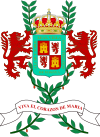Masaya
| Masaya | |||
|---|---|---|---|
| Municipality | |||

La Asunción church in the Central Park of Masaya
|
|||
|
|||
| Location in Nicaragua | |||
| Coordinates: 11°58′N 86°06′W / 11.967°N 86.100°W | |||
| Country |
|
||
| Department | Masaya Department | ||
| Government | |||
| • Mayor | Orlando Noguera | ||
| Area | |||
| • Municipality | 55.1 sq mi (142.6 km2) | ||
| Population (2005) | |||
| • Municipality | 139,701 | ||
| • Density | 2,500/sq mi (980/km2) | ||
| • Urban | 110,958 (5th Nicaragua) | ||
Masaya (Spanish pronunciation: [maˈsaʝa]) is the capital city of Masaya department in Nicaragua. It is situated approximately 14 km west of Granada and 31 km southeast from Managua.
The town of Masaya is just east of Masaya Volcano (Volcán de Masaya), an active volcano from which the city takes its name. With an estimated population of 140,000 (2005), it is Nicaragua's third most populous city, and it is culturally known as the City of Flowers.
During the Nicaraguan civil war of 1912, Nicaraguan rebel forces opened fire on American Marines and sailors passing through the city on their way to Granada on September 19, 1912.
Masaya is located centrally to a large agricultural production region in Nicaragua. Much of the production from the departments of Masaya and Carazo and the surrounding areas is shipped through Masaya on its way north, towards Managua and Leon. Masaya is also a notable industrial center, producing footwear and clothing. Other industries in the city include the processing of fiber and the manufacture of cigars, leather products, soap, and starch. Many of the communities surrounding Masaya produce hardwood and wicker furniture, and there is a neighborhood in Masaya near the lake dedicated to the production of hammocks.
Masaya is known as "The Cradle of Nicaraguan Folklore" and is the very heart of Nicaraguan handicrafts. The main market in Masaya is located next to the central bus station. The market is divided into sections, with each section serving a different need. Aside from unique Nicaraguan products such as hand woven hammocks, embroidered blouses, wood carvings, and hemp weaving the market is very diverse. An entire section of the market is dedicated to selling electronic devices and clothing, while another area is reserved for raw meat. Everything is available in the market from hardware and beauty supplies to produce from the surrounding area.
...
Wikipedia



